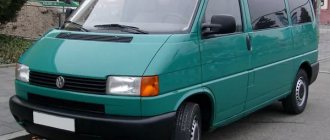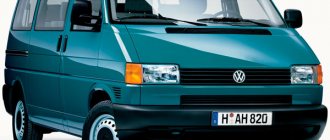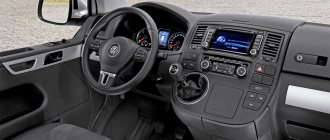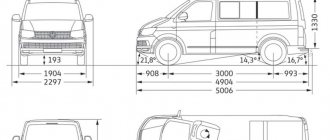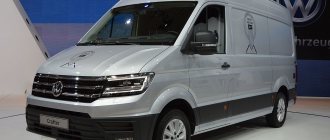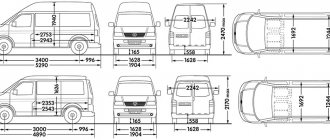| Manufacturer: | Volkswagen AG (Germany) |
| Model: | VW Transporter Kasten 4Motion (7JO) |
| Test car price: | RUB 2,568,700 |
Andrey Filippov, photo by the author
I tap the bright orange “people’s” VW Transporter van in front of me, hoping to find caches of diamonds or at least a couple of body parts made of gold or platinum. Alas, the bare metal of the cargo compartment and the standard cabin trim turn this hope into dust - the most ordinary commercial LCV class van. Then where does such a fabulous price come from, putting the commercial baby on par with business class sedans and luxury SUVs?
Well, this is a Volkswagen, and as the father of Russian democracy, Kisa Vorobyaninov, used to say: “I believe bargaining is inappropriate here!” The “people's car” has recently noticeably improved in manufacturing quality, in the technologies used, in the filling and in reliability. From a separate company it has grown into a giant concern, but... Sadly, prices for the entire model range, including the semi-commercial branch, have also increased noticeably.
Diesels: the simpler the better
The 1.9-liter four-cylinder diesel engine runs more than half a million kilometers without problems. However, the tandem of “poor quality oil and a sloppy owner” will ruin any perpetual motion machine. Poor lubrication will cause camshaft beds to scuff, and cheap tractor diesel fuel will cause pump injectors to die. A new injector costs about 40 thousand rubles.
The most reliable and unpretentious engine for the Transporter is a 1.9-liter diesel engine.
The most reliable and unpretentious engine for the Transporter is a 1.9-liter diesel engine.
Transporter Kasten
The production of the Volkswagen Transporter began 60 years ago. The fifth generation of the legendary model has retained all the advantages that brought success to its predecessors: absolute reliability, excellent dynamics and enviable efficiency. Volkswagen relatively recently released the fifth generation of the Transporter light-duty truck with the T5 index. What's more, the new Transporter doesn't just repeat its success, it raises the bar for light commercial vehicles much higher. It again has no equal in its richness of technical innovations and variety of design options.
The new model offers more payload and cargo space options through a longer wheelbase. There's also a choice of six durable engines that deliver high torque across a wide rpm range. Engines are offered both diesel and gasoline of different sizes and powers. We took one of the representatives of this family for testing. This is, at first glance, a simple small all-metal van. Upon initial inspection, the car pleased me with its modern appearance.
The T5 differs from the previous generation in a modified front part, more precisely the bumper and headlights, as well as a completely updated interior. The cabin as a whole and interior details are designed in full accordance with the latest ergonomic requirements. The solid glazing of the cabin indicates excellent visibility. The front bumper features a radiator grille with an emblem that goes well with the updated powerful headlights. Large exterior rear view mirrors are electrically adjustable and electrically heated.
The cabin doors open to a very large angle, forming a solid opening with a comfortable wide step located at the bottom of the opening, behind the front wheel fender. So getting into the car is easy. There are storage niches in the doors. The window lifts, unfortunately, are mechanical. You can take a driving position that provides the best view. This is facilitated by a comfortable anatomical seat of a form-fitting shape with a headrest, which is adjustable for the longitudinal position and the angle of the backrest, as well as a safety steering column, adjustable for reach and tilt. An airbag is mounted in the small-diameter steering wheel hub.
The hydraulic booster makes it easy to maneuver in city traffic. The small joystick of the gearbox in the front panel is also conveniently located: you don’t have to reach for it. The instrument cluster contains all the necessary information. The only thing that surprised me was the absence of a coolant temperature sensor. This is a clear disadvantage for a car of this class. On the central part of the front panel there is a storage shelf, and just below there is a small pull-out block that houses an ashtray with a cigarette lighter and two folding cup holders. Of course, the van we tested also has space for passengers: a two-person seat to the right of the driver with a built-in storage compartment that has no adjustments.
Opposite is a glove compartment for things and documents, which is locked with a key. In general, everything is in order with ergonomics.
To protect the driver and passengers in an emergency situation when transporting goods, the cabin and cargo compartment were separated by a reliable solid partition. The van's 5.8 cubic liter load compartment is comfortable to work in in every way. The rectangular shape of the body allows optimal use of its volume, and the durable and rigid metal structure is designed for a long service life, as it is partially galvanized. By the way, the warranty against through body corrosion is 12 years, which allows you to save on operating costs in the long term.
The rear hanging door, as well as the side sliding door, which is located on the right side in the direction of travel of the car, will help save time when loading or unloading. To securely secure the load, there are 6 lifting loops. The tested van was equipped with a four-cylinder turbodiesel with direct fuel injection through pump injectors. Displacement – 1.9 liters, maximum power – 86 hp. at 3500 min-1, maximum torque – 200 Nm at 2000 min-1, Euro-3. It is worth noting that this diesel engine has a low level of vibration and noise characteristic of engines of this type.
It is coupled with a 5-speed manual transmission. The suspension on the car is front and rear independent with telescopic shock absorbers. In front there are McPherson struts, in the rear there is a strut with shortened coil springs. Front and rear stabilizers are installed. The braking system is hydraulic, front and rear disc brakes, with ABS and switchable ASR traction control system. All of this comes standard on the truck we tested. For an additional fee you will be offered a huge list of options; you can also order a second sliding door.
On the road the car behaves quite briskly, but at the same time rationally. A modern, powerful engine that develops high torque creates sufficient active safety potential at maximum load and allows the driver to freely react to changing situations. The independent suspension ensures a stable body position above the road and allows you to corner along a given path, sometimes at higher speeds. There are no complaints about the braking system.
Having done several test braking tests on a basalt surface, we were convinced that the ABS worked well. The traction control system also turned out to be excellent; we sharply dropped the clutch pedal (on the same basalt surface), the car began to move without slipping the wheels. I would like to point out that the optimal complement to these two systems is the MSR engine braking regulator. For example, when releasing the gas suddenly or when engaging the clutch after downshifting, it prevents the drive wheels from skidding on a slippery road.
To sum it up, we can say that the Transporter is a worthy answer to any challenge. Thanks to its efficiency, reliability and pleasant appearance, it meets all modern requirements of a delivery van. It’s not for nothing that in 2004 it won the title of “Best Van of the Year”!
©. Photos taken from publicly available sources.
- Author: Evgeny Smolnikov
Rate this article:
- 5
- 4
- 3
- 2
- 1
(0 votes, average: 0 out of 5)
Share with your friends!
Transporter 5
Transporter 3
Diesels 2.0 TDI: a lot of childhood diseases
In 2009, the T5 changed its engine range, receiving two-liter engines with one and two turbines. But the steep dual supercharging turned out to be unreliable. However, not only the dampers and turbines became the weak link of the powerful 2-liter version. Almost new cars consumed as much as 2–3 liters of oil per 1000 km! With such a serious appetite, the piston rings stuck quickly and firmly, and the engines required a rebuild.
The Transporter was equipped with four versions of the 2.0 TDI diesel engine with power ranging from 84 to 180 hp.
The Transporter was equipped with four versions of the 2.0 TDI diesel engine with power ranging from 84 to 180 hp.
In 2013, Volkswagen changed the design of the pistons. The problem has subsided, but has not completely disappeared. And only after a generation change they found out: the exhaust gas cooler is to blame for the oil burn. It corrodes from the inside, and aluminum chips, getting into the cylinder, become an abrasive that grinds down the parts of the cylinder-piston group.
Slot machines: go up to 300 thousand!
Before the “restyling” it was a cool 6-speed Aisin, which was specially strengthened for tough commercial use. The Asian “six-speed” serves 300-400 thousand km without problems. Just don’t forget to change the oil in it every 40–60 thousand km.
After the update, a robotic DSG appeared, the unreliability of which the owners of Volkswagen passenger cars know firsthand. However, the wave of failures and breakdowns bypassed commercial Volkswagens: they got the strong DQ500 (DSG 7) unit. True, before the big revision in 2011, the preselective had the habit of “kicking” and “pushing,” but then the box was radically improved. The service life of this transmission is up to 300,000 km with regular maintenance.
Transporter T5 was the first model to have the DSG DQ500 robotic gearbox installed. And this is the most reliable unit of all DSGs.
Transporter T5 was the first model to have the DSG DQ500 robotic gearbox installed. And this is the most reliable unit of all DSGs.
Suspension: hard but reliable
The T5 uses a classic design - McPherson struts at the front and trailing arms at the rear. The walker turned out to be practical, durable and almost without weak points. The only complaints that were raised were the rear silent blocks of the front control arms and the support bearings of the shock absorber struts. But these are trifles, especially since after 2009 they began to install stronger bearings.
The suspension is very durable on all Transporters, regardless of the type of drive and power unit.
The suspension is very durable on all Transporters, regardless of the type of drive and power unit.
The definite plus of the suspension is survivability, and the minus is that it is rigid. A simple upgrade will help to improve the behavior a little: we introduce silent blocks from the armored version, tires from the crossover and we get the same thing, only softer and more pleasant.
A few lines about the main thing
Oddly enough, we never got around to really testing the entire model range of the updated Transporter / Caravella / Multivan family. And the point here is not that the “semi-merchants” of the VW press park are always in great demand among our brethren, but that the designers managed to reach almost the pinnacle of technical perfection of the current generation, and the next restyling brings, rather, aesthetic changes than a global improvement in the filling .And if so, why pour from empty to empty?
The reason for the appearance of the “orange” van on the pages of the magazine was the combination of a simple-looking van with an all-wheel drive transmission and the already mentioned price tag - the product turned out to be very contrasting.
Despite the apparent simplicity of the interior with a metal floor and lack of optional plywood lining, the cargo compartment turned out to be quite functional. The car took part in the transfer of old furniture to the dacha, during which it allowed us to appreciate the convenience of high doorways - we managed to bring the kitchen cupboard inside without turning over. And securing it in a vertical position was not difficult - many holes in the frame of the van and the metal partition happily “provided” places for attaching ties.
As for the all-wheel drive, it is “automatic” - there is a Haldex clutch under the bottom, which divides the torque in a ratio of 95:5 under normal conditions and transfers it to the rear wheels when it comes to the front wheels slipping. In principle, the scheme is standard for VW. Just in case, an inter-wheel locking of the rear axle is provided.
As for the price?.. Let's see, maybe not everything is as scary as the “zeros” make it out to be.
What will you take?
So, “Dorestyle” is good with both engines and gearboxes. But it’s a bit old: the newest cars are more than ten years old!
And when choosing a restyled Transporter, it is important not to chase power. You can and should live without 180 horses, a DSG gearbox and a 4x4 drive.
- When planning to go off-road, it is always better to put chains on your wheels in advance. If the need for chains is not obvious, make sure that bracelets are available. Anti-skids and anti-skid bracelets will not be superfluous. If you are planning a long trip, we recommend that you take a closer look at snow chains.
- “Behind the Wheel” can now be read in Yandex.Zen.
VW Transporter: is there really nothing to break in it? Almost!
Give me some dirt!
Journalists are like little children, and a test drive of any all-wheel drive off-road vehicle is a reason for them to get into the mud up to their very roof. Naturally, I am no exception. When my plans for the end of April - beginning of May included a test drive of the VW Transporter Kasten 4Motion, then, of course, mud baths were almost in my first place, but...
The weather decided everything in its own way. The spring sun melted the snow, but there were no heavy rains. As a result, off-road turned from a full-fledged study of the van’s off-road capabilities into, rather, scouring the “ambush” places known to me in search of an acceptable level of dirt. In the end, I probably covered a couple of hundred kilometers along dirt and forest paths, but I still couldn’t find a place where I could even take a spectacular shot with splashes in different directions, not to mention a full test of the all-wheel drive.
No, of course, I found real dirt. But it is logical to predict that it has been preserved in places where an adequate driver can only get into a full-fledged SUV, preferably with a winch, and not in a commercial van shod with all-season Nokian Hakkapelita C tires. Actually, I also considered myself among the “adequate” ones. therefore, there will be no exciting story about a car drowned in a puddle and a search expedition to save it.
But I can say with confidence that driving over rough terrain was not a problem for our test subject. Short overhangs and a relatively small wheelbase made it possible to confidently maintain a fairly high speed on dirt roads, without fear of not having time to brake before a very sharp bend. The result is a lot of pleasant sensations for me and no technical losses for VW. Not bad for a car with the appearance of a city dude.
However, the VW Transporter still suffered a loss, and in a place where you wouldn’t usually expect it. On the M-1 Belarus highway, near the border between the Moscow and Smolensk regions, a hare came out to intercept the van. The time was closer to midnight, and the track was free - the speed at the time of the attack was exactly the secretly permissible 120 km / h, and the only thing I managed to do before the resounding “boom!” was... well, yes, express a verbal wish do not cross the road in the wrong place, expressed in one succinct word.
Fortunately, it happened 50 meters in front of a gas station, and I immediately rushed to inspect the damage by the light of the lanterns - after all, Minsk was still more than 500 km away, and standing somewhere in a field with a jammed engine did not smile at me. But either the hare was small, or the additional 200 mm of ground clearance, “donated” by the reinforced suspension, played a role (for front-wheel drive versions it is offered for 33,800 rubles), or competent plastic engine protection, made in the form of a “ski”, was made your own business. The only problem was the torn-off bottom plate for attaching the license plate. By the way, I didn’t find the hare itself, nor any traces of his presence, maybe I just imagined it?..
And now, as usual, dry numbers from impartial instruments, fortunately, a mileage of 3276 km allows us to draw some conclusions.
Firstly, if we abstract from the specifics, the average fuel consumption figures fall within the range of 8.5–9.5 l/100 km. This applies to real traffic on asphalt roads: with populated areas, stops with the engine running and other vital moments. It is these values that I would recommend focusing on when calculating estimated fuel costs.
Secondly, if you maintain ideal conditions of uniform driving within 100 km/h, you can get a very rosy 6.9 l/100 km, which for a fairly tall van is not too bad.
Thirdly, keep in mind that all the data was obtained on an empty van, but since the load capacity is small, and the dynamic style of journalistic driving in everyday life is unlikely to be used by anyone on a commercial vehicle, the figures can be taken on faith without a percentage on the load. Naturally, I can’t say anything about the error of the on-board computer.
Once again I cannot help but note the already sore dissatisfaction with the new VW engines.
It seems that you can get used to the lack of low-end traction if you constantly use only “people’s cars” or don’t skimp on a robotic gearbox. Alas, journalists cannot afford to adhere to one brand, so each test of the next Volkswagen begins with the engine stalling when starting off. However, perhaps I’m just so clumsy, but it is what it is. Fuel consumption of the VW Transporter Kasten 4Motion
| Driving mode | Desired speed, km/h | Real speed, km/h | Fuel consumption, l/100 km |
| Route | 100 110 130 | 73 86–100 115–118 | 6,9 8,2–8,5 9,1–9,5 |
| City | 80 (Moscow) | 22–27 | 10,5–9,2 |
| Mixed | – | 47–62 | 8,2–8,9 |
Dependence of speed on engine speed VW Transporter Kasten 4Motion
| Speed, km/h | 80 | 90 | 100 | 110 | 120 | 130 |
Engine speed, min-1:
| 1600 1200 | 1800 1400 | 2000 1600 | 2200 1800 | 2400 2000 | 2600 2200 |
However, the 6-speed manual transmission perfectly eliminates all the nuances of “compact” VW engines, and in daily use there are no problems with them either in terms of dynamics or in terms of fuel consumption.
And this time everything is logical with the gears - the speedometer and tachometer readings change synchronously, which is good news compared to other brands. The only point is that when the speed decreases to 80 km/h, the car requires a shift to V gear. So in urban conditions, stage VI is used only when walking along the streets at night, when Yandex declares that traffic jams are “0 points”.
Finally, I note that I did not detect any noticeable “windage”. Yes, with sharp gusts of wind you can feel the pressure of the air currents on the tall body, but it’s impossible to say that this forces you to grip the steering wheel tighter, much less adjust the course. The car strictly maintains its trajectory, allowing you not to strain too much even on a long journey.
